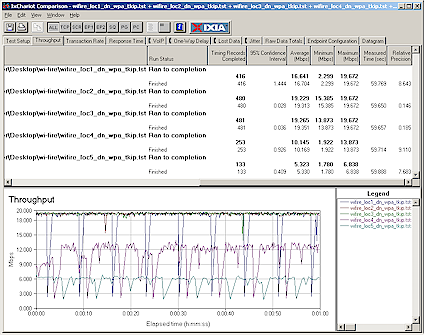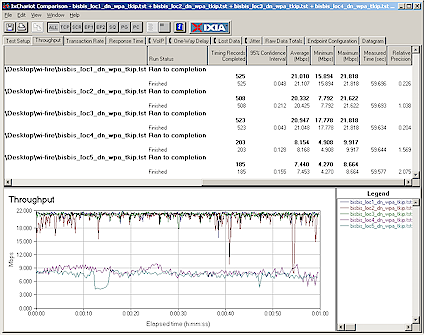Performance
I really wanted to use the Azimuth W-Series WLAN Test Platform that I've used for my recent MIMO testing to plot throughput vs. range curves for the Wi-Fire. But time pressures made me abandon that idea - at least for now. So instead I used IxChariot to run tests at my five indoor test locations. (The complete setup is described here.) I used a Linksys WRT54G wireless router as my AP, primarily because it is so commonplace in home setups.
Since I've been unpleasantly surprised recently by severe throughput reduction with WEP and/or WPA enabled in some draft 11n MIMO products, I've resumed taking a closer look at performance in these modes for all wireless products. I checked Location 1 throughput with the Wi-Fire set to WEP 128, WPA-PSK TKIP and WPA2-PSK (AES) modes and was pleasantly surprised to see no significant throughput difference among modes.
Note that the Wi-Fire supports WPA TKIP only and not the optional AES encryption supported by some products. AES is, of course, supported in WPA2 modes. I also found that enabling "Enterprise" in the Privacy Super Profile setting enabled PEAP - MS-CHAP-V2, PEAP - GTC and TLS options. "Enterprise" mode also turned on the "Enable CCX mode" checkbox that is unavailable with Privacy Super Profile set to "Personal".
The main reason you'll buy the Wi-Fire, however, is to improve your WLAN connection and there I had not exactly convincing results. Figure 8 is a composite IxChariot plot of one minute throughput runs in my five indoor test locations. Throughput in Locations 1 through 3 are pretty much the same, as I typically have found with other wireless products. Note that in Locations 4 and 5, I used the Wi-Fire Utility to find the strongest signal before running the test. I do not normally try to find the best signal before running the tests, but instead use the same notebook placed in the same position for each test.

Figure 8: Wi-Fire Downlink Throughput vs. Range (click image to enlarge)
The Wi-Fire actually does quite well in the tougher Locations 4 and 5, compared even to many of the MIMO notebook Cardbus adapters I've tested. But it doesn't provide significantly better performance than the best adapters I've tried. Figure 9 shows another composite IxChariot plot, but this time using my test notebook's built-in wireless adapter.
The adapter is a dual-band Gigabyte GN-WPEAG mini-PCI board using an Atheros Super AG chipset that I installed myself shortly after getting the notebook last year. Figure 9 shows that the internal notebook adapter actually turns in higher average throughput in most cases, primarily thanks to the lack of the periodic throughput "dropouts" that the Wi-Fire has. Note that I also positioned the notebook for best throughput before running the complete tests.

Figure 9: Notebook Downlink Throughput vs. Range (click image to enlarge)
Table 1 pulls together the average throughput values from both runs, where you can see that the only place that the Wi-Fire bests my notebook's internal adapter is in Location 4.
| Location | Wi-Fire | Internal Notebook |
|---|---|---|
| 1 | 16.7 | 21.1 |
| 2 | 20.9 | 20.4 |
| 3 | 19.4 | 21.0 |
| 4 | 10.2 | 8.2 |
| 5 | 5.3 | 7.5 |